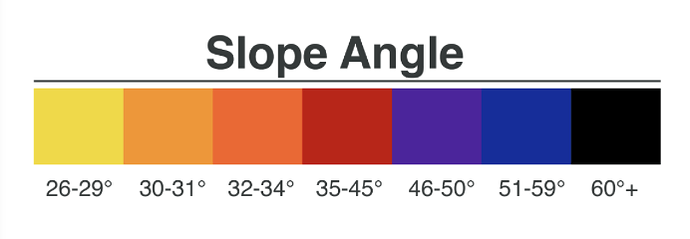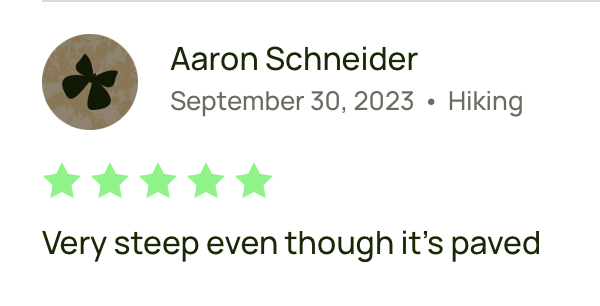Well, got waylaid with some engine issues on my vehicle and a client coming out of the woodwork, but here’s where I stand on foot_scale. I’ll probably make a splinter thread soon (I’ve been gathering a lot of photos on different terrain / areas) but figured I’d toss it out for some quick feedback if anyone is interested. I’ve taken a lot of good points from this thread and incorporated them!
I’m curious if people find it better or worse. It’s certainly not as terse, but I personally feel it probably helps avoid ambiguity as well as set expectations for more casual or recreational users while transitioning into “semi-technical” terrain. ![]()
Value 0: casual_or_attentive_FIXME
foot_scale=casual_or_attentive_FIXME
This value would exist for data ported over from the existing sac_scale T1, as there’s no real way to tell if the path should be either casual or attentive.
Value 1: Casual
foot_scale=casual
Requires little to no attention to traverse, very accessible
The ground may not be entirely smooth and clear but it has few to no obstacles. If there are obstacles they are to be minor and/or have a large amount of space around them. These paths can often use imported materials for their surfaces (gravel or asphalt), but can also be on naturally occuring firm ground where traction is not an issue. The path must be wide enough for two people to walk side by side or for two people in opposing directions to go past each other without stepping off of the path. Steep drop offs must have a railing or some other means of protection.
Expectation:
- Accessibility/Safety: In general anyone that can walk (even with some mobility issues) like those that need to use a walking aid, the very young and elderly, etc can safely traverse this terrain.
- Focus: Little to no focus is needed, people can walk and talk and not pay much attention to the path surface.
- Footwear: Almost all casual footwear will be adequate.
Roughly equivalent to local scales:Class 1 YDS, ~NFS Class 4-5 Trails, SAC T1 / Yellow, Austria Blue, CAI T, AWTGS Grades 1, PWS W1 & W2
Note: Casual walking paths that are wheelchair accessible should be tagged with wheelchair=yes.
Value 2: Attentive
foot_scale=attentive
Requires attention to traverse, but still relatively straightforward
These generally are either narrow enough that people need to walk single file (and step off to pass), have steep unprotected drops off of the side, or some modest yet impactful obstacles. Obstacles are generally ankle to knee high like roots or rocks - though these can almost always be avoided and it is possible to walk on an even or nearly even surface. The surface itself still provides good traction regardless of obstacles, but you may need to pay attention in places.
Expectation:
- Accessibility/Safety: People that need to use aids when walking, or have a minor issue that impacts their mobility can have problems in sections but should be able to safely complete it.
- Focus: People need to be attentive of obstacles or footing to avoid tripping or slipping, but can still split their attention to easily carry on a conversation etc.
- Footwear: Sneakers or other casual footwear should be fine.
Roughly equivalent to local scales: Class 1 YDS, ~NFS Class 2-3 Trails, SAC T1 / Yellow, Austria Blue, CAI T, AWTGS Grades 2, PWS W1 & W2
Value 3: Surefooted
foot_scale=surefooted
More complex terrain that requires surefootedness to traverse
Where attentive path surfaces have obstacles that can largely be avoided, this terrain requires people to be able to move with balance and coordination (be surefooted) to maintain traction. Having to lift up your legs to move over uneven rocks and roots and then step down on an uneven surface for an extended period of time is common. It can also include moving through mud, wet clay, slick or loose surfaces, etc where the surface itself is essentially an obstacle due to poor traction. A path is also surefooted if it is obscured enough you can’t see where you are stepping, as you may need to react quickly if stepping onto an uneven or loose surface.
Expectation:
- Accessibility/Safety: If someone has mobility or balance issues they may be unable to proceed safely or comfortably on this terrain. This can be very challenging to inexperienced hikers, but will be straightforward for mountaineers.
- Focus: Attention will need to paid to footing for long stretches in places to avoid loss of traction or falling.
- Footwear: This is more consequential. Lightweight but outdoorsy shoes like trail runners or approach shoes would be helpful, but sneakers should still work though more care might need to be taken at times. People with bad ankles or that lack experience may want traditional mid or high top boots.
Roughly equivalent to local scales: Class 1 YDS, NFS Class 1-3 Trails, SAC T2 / White-Red-White, Austria Red, CAI E, AWTGS Grade 3?, PWS T1-T2
Value 4: Hands for Assistance
Rougher terrain requires hands for balance, or to push off/pull onto/pass through obstacles
foot_scale=hands_for_assistance
The path surface that is uneven or steep enough that it’d be reasonable to expect people to require use of their hands or trekking poles to safely traverse it. Obstacles like larger talus or boulders where you need to put a hand on a piece here or there to support yourself, aid with balance, or move around it. You might be occasionally be pushing off or pulling up on obstacles, but you aren’t actually using them to scramble or climb and you aren’t searching for mulitple handholds in a row. Having to actively push through bushes or branches to proceed as opposed to just brushing them out of the way occasionally would also fall into this category.
Expectation:
- Accessibility/Safety: You need a stronger sense of balance and coordination than on
surefootedterrain. Being able to control your body’s momentum and be aware of your weight and how it is moving over obstacles is important. - Focus: Intense concentration is often necessary. The ability to think a few steps ahead and a little bit of confidence when focusing on the path are very helpful.

- Footwear: At this point something with grippy soles meant for hiking is recommended. These can still be very lightweight for experiened individuals.
Roughly equivalent to local scales: Class 2 YDS, NFS Class 1-2 Trails, SAC T3 / White-Red-White, UAII 1, Austria Black, SWW White-red-white, CAI EE, AWTGS 3-4?, PWS T3-T4?, BMC Grade 0.5?
Value 5: Scrambling
More vertical terrain where hands are used to climb/scramble, but is simpler than technical climbing=*
foot_scale=scrambling
Obstacles: High angle obstacles that need to be “climbed” finding handholds and footholds and pulling oneself up, but are simpler than technical climbing=* which use of a rope and harness are expected. Feet are off the ground for more than a few moves, or there are repeated sections of short climbing.
Expectation:
- Accessibility/Safety: You need to be able to pull up your body weight with upper body strength. While not considered “technical climbing” significant risk can be involved. Previous climbing or mountaineering experience is highly recommended.
- Focus: Loss of focus can have very serious consequences.
- Footwear: approach shoes, “high route shoes”, cross trainers, or boots are recommended. You’ll generally want either more traditional boots with “structure” or a lightweight shoe that conforms to the foot for better feel and independent use of foot muscles for control.
Roughly equivalent to local scales:: Class 3 YDS, Bouldering VB, NFS Class 1 Trails, SAC T4-5, UAII 2, Austria “Alpine Route”, CAI EE, AWTGS 4-6?, PWS T3-R?, BMC Grade 1-3
OSM Mapper Note: Some hiking systems overlap into technical climbing - SAC T6 regularly covers extended UIAA 2, YDS 4 goes into the lower range of Class 5, etc. These are far closer to technical climbing routes than recognizable paths that people can follow on foot, and are not appropriate for this scale. This is going to be a slim minority of paths in most regions.
Just marking a section of a path as a scramble is useful. More technically minded people can add on a local scale to help differentiate grades of scrambling - BMC, YDS, SAC, etc.



